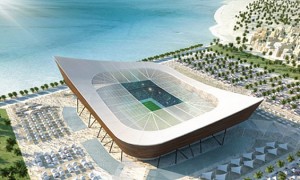By Armstrong Vas www.thepeninsulaqatar.com
Doha: Qatar 2022 World Cup will leave a lasting legacy for many generations to come and open up new horizons making it possible for countries with hot climates to host sporting events using environmentally friendly solar powered stadium cooling systems, said Nasser Al Khater, Head of Communication and PR of Qatar 2022 Supreme Committee.
 Al Khater was speaking at the one-day Coliseum Summit 2011 organised by Coliseum Sports Venues of the World, Dubai on Sports Venues Know-how for the Middle East, at Four Seasons Hotel here on Wednesday, attended by experts from the sports venue industry.
Al Khater was speaking at the one-day Coliseum Summit 2011 organised by Coliseum Sports Venues of the World, Dubai on Sports Venues Know-how for the Middle East, at Four Seasons Hotel here on Wednesday, attended by experts from the sports venue industry.
Elaborating on the cooling technological innovation Al Khater said, “Al Sadd Stadium is one of the few stadiums in the world which is using traditional energy sources. We wanted to replicate the same technology at a large stadium, but there were environment concerns. The cooling technology, we will be using to cool stadiums during the 2022 World Cup is carbon zero, it has been successful in the proto type stadium of 500 seats and the technology has successfully worked at bigger stadiums.”
The cooling technologies will also be shared with countries that have similar climates to Qatar, he added.
“We intend to provide opportunities for countries to host events that would previously have been unable to due to climate difficulties. These are the ideas we consider as serious and they provide a genuine legacy for football, opening up possibilities for new regions of the world,” Al Khater said.
“All the stadiums will have environmentally friendly cooling technologies to ensure cool and comfortable temperatures for players and supporters — about 27 degrees Celsius,” he added.
Updating the gathering on the planning status of the 2022 stadiums and what has happened since the bid was won Al Khater said the Word Cup will be played at 12 venues.
“We have planned meticulously since day one of the bidding process and the work started the day after we were awarded the tournament on December 2, 2010. We will build nine new stadiums and three existing stadiums, Khalifa Stadium, Al Rayyan and Al Gharafa will be redeveloped. The jewel of the crown among the stadiums will be the Losail Stadium at Losail city, which will host the opening ceremony and the final, with a capacity of 86, 250,” disclosed Al Khater.
Qatar, he said, has planned meticulously since day one of the bidding process and the work started the day the country was awarded the tournament on December 2.
“We have been building a strong foundation from Decembers 2. In March 2011, we formed the Qatar 2022 Supreme Committee with the purpose of ensuring successful and timely delivery of all vital projects that are necessary to host an amazing 2022 FIFA World Cup. While the Qatar 2022 Supreme Committee will be directly responsible for delivering the stadia and training facilities for the FIFA World Cup, it will have more of an oversight role with other important projects which relate to hosting the FIFA World Cup.
Hotels, roads infrastructure, the metro network system are just a few examples. While all these projects have their relevant authorities which are responsible for their delivery it is important for the Qatar 2022 Supreme Committee to stay abreast of developments.”
“In 2012, we will appoint a Programme Management Consultant (PMC). The PMC and the Supreme Committee will work together to create the Road Map until 2022 and beyond and to ensure all the systems are in place,” he added.


















